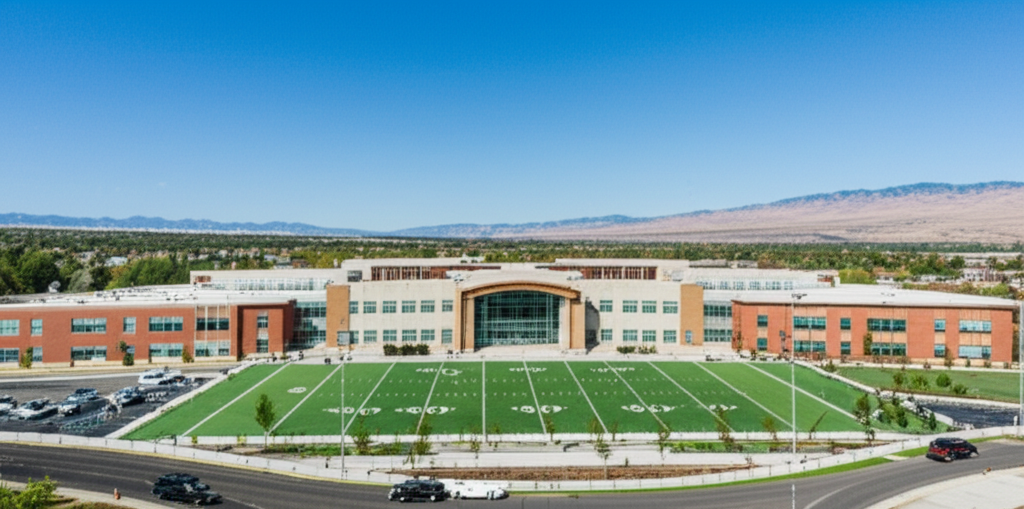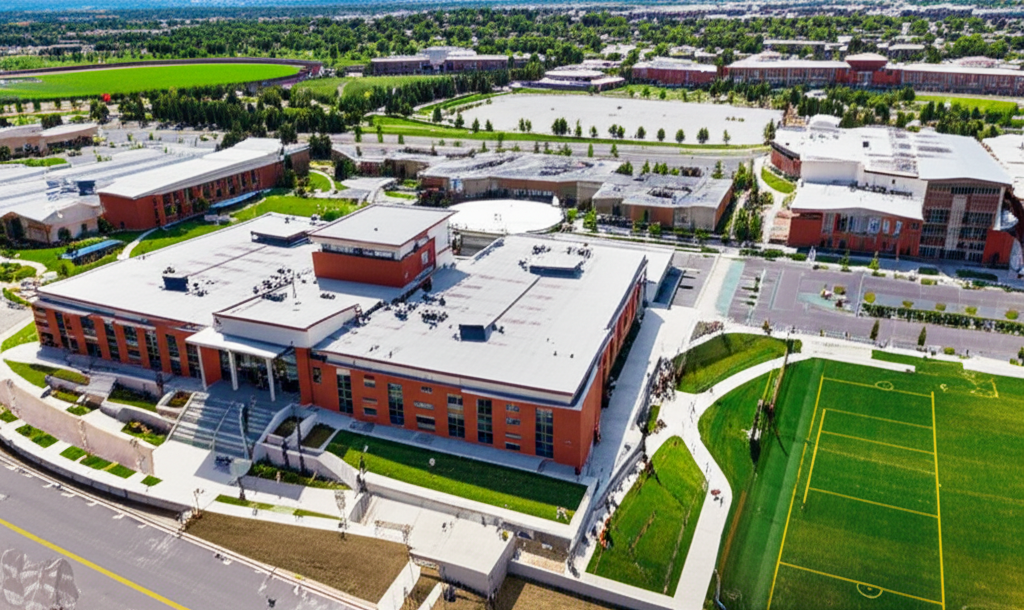Utah’s biggest high schools are impressive institutions, often boasting large student populations and diverse academic programs. Discover which ones stand out and what makes them so significant for students and communities across the state.
Finding the right high school can feel like a big decision, and understanding the landscape of Utah’s educational system is a great place to start. When we talk about the “biggest high schools in Utah,” we’re not just talking about numbers; we’re often referring to schools that are hubs of activity, offering a wide range of opportunities for students. These larger schools can provide extensive course selections, numerous extracurricular activities, and a vibrant student life. This guide is designed to make that information easy to understand, even if you’re new to exploring school data. We’ll walk through what makes these schools “big,” how to find them, and what benefits they might offer. Let’s dive in and explore some of Utah’s most impressive high schools!
Understanding “Biggest” in Utah High Schools
The term “biggest” when referring to high schools in Utah can mean a couple of things. Most commonly, it refers to the total number of students enrolled. Schools with higher enrollment often have more resources and a wider variety of programs. However, “biggest” can also imply the most expansive campus, the most extensive list of academic offerings, or the most significant impact on its surrounding community. When we look at the biggest high schools in Utah, we’re often seeing a combination of these factors. These institutions are more than just places of learning; they are centers of community, innovation, and student development.
Enrollment: The Primary Measure
Enrollment numbers are the most straightforward way to rank the size of a high school. A larger student body typically means more classrooms, more teachers, and a broader spectrum of student interests and talents. For students, this can translate into more choices for classes, clubs, and sports. For parents, it might mean access to specialized programs or advanced academic tracks. The Utah State Board of Education provides data on school enrollment, which is a reliable source for understanding these numbers. For example, looking at data from the Utah State Board of Education (often found on their official website, https://schools.utah.gov/) can give you precise figures.
Larger schools often have the advantage of economies of scale. They can afford to offer more specialized electives, advanced placement (AP) courses, and career and technical education (CTE) programs that might not be feasible in smaller schools. This diversity of offerings can help students explore different career paths and academic interests before graduation, preparing them for college or the workforce.
Beyond the Numbers: Program and Impact
While enrollment is key, the “biggest” schools in Utah often stand out for their comprehensive programs and their significant role in their communities. These might include:
- Extensive athletic programs with multiple teams for various sports.
- Robust arts departments offering theater, music, visual arts, and more.
- Advanced academic pathways like International Baccalaureate (IB) programs or numerous AP courses.
- Strong vocational and technical training opportunities preparing students for skilled trades.
- A wide array of student clubs and organizations catering to diverse interests.
These elements contribute to a school’s overall “bigness” by showcasing its capacity to serve a broad range of student needs and foster a dynamic learning environment. The impact of these schools often extends beyond their walls, influencing local culture and economy.
Identifying Utah’s Largest High Schools
Pinpointing the exact list of the biggest high schools in Utah can shift slightly year to year based on enrollment fluctuations. However, several institutions consistently rank among the largest in the state. These schools are often found in or near Utah’s most populated areas, such as Salt Lake County, Utah County, and Davis County.
Top Contenders by Enrollment
Based on recent data, some of the biggest high schools in Utah, by student enrollment, consistently include:
Here’s a look at some of the schools that frequently appear at the top of enrollment lists:
| High School Name | District | Approximate Enrollment | Key Programs/Features |
|---|---|---|---|
| Skyline High School | Salt Lake City School District | 2,000+ | Strong academics, diverse extracurriculars, AP programs |
| Cottonwood High School | Salt Lake City School District | 1,900+ | International Baccalaureate (IB) program, robust arts |
| Brighton High School | Canyons School District | 2,100+ | Award-winning programs, extensive AP offerings, strong athletics |
| Alta High School | Canyons School District | 2,000+ | Comprehensive curriculum, emphasis on college readiness |
| Timpanogos High School | Alpine School District | 2,200+ | STEM focus, strong arts programs, large student body |
| Pleasant Grove High School | Alpine School District | 2,300+ | Diverse CTE options, competitive sports, large enrollment |
| Orem High School | Alpine School District | 2,000+ | Renowned for academics and extracurriculars, significant student population |
| Davis High School | Davis School District | 2,400+ | One of the oldest and largest, extensive course catalog, strong community ties |
| Viewmont High School | Davis School District | 2,100+ | Comprehensive offerings, active student life, large student body |
| Syracuse High School | Davis School District | 2,200+ | Modern facilities, strong focus on STEM and college prep |
Note: Enrollment figures are approximate and can vary annually. For the most current data, consult the Utah State Board of Education or individual school district websites.
Where to Find Official Data
The most reliable source for enrollment data and other school statistics in Utah is the Utah State Board of Education. Their website offers searchable databases and reports that detail student demographics, academic performance, and school profiles. Many school districts also publish their own data on their respective websites, which can provide more localized insights. Looking at these official sources ensures you are working with accurate and up-to-date information.
When reviewing this data, pay attention to the reporting year. Enrollment numbers can change, especially with population growth in certain areas of Utah. Understanding the context of the data helps in making informed comparisons.
Benefits of Attending a Large High School

Attending one of the biggest high schools in Utah comes with a unique set of advantages. These schools are often equipped to offer a breadth and depth of opportunities that smaller institutions might not be able to match. For students, this can lead to a more personalized educational journey and a richer high school experience.
Diverse Academic Opportunities
One of the most significant benefits of larger schools is the sheer variety of academic programs available. Students can often find:
- A wider selection of Advanced Placement (AP) or International Baccalaureate (IB) courses, allowing for college-level learning in high school.
- More elective courses in subjects like foreign languages, arts, technology, and specialized sciences.
- Dedicated career and technical education (CTE) programs that prepare students for specific industries.
- Specialized learning centers or academies within the school focused on areas like STEM, performing arts, or entrepreneurship.
This extensive academic catalog empowers students to tailor their education to their specific interests and future aspirations, potentially earning college credits or gaining valuable skills before graduation.
Extensive Extracurricular Activities
Larger student populations naturally lead to a more robust and diverse range of extracurricular activities. Students at these schools often have access to:
- More sports teams across various levels (varsity, junior varsity) and a wider array of sports offered.
- A greater number of clubs and organizations, from debate and robotics to environmental clubs and cultural associations.
- More opportunities in performing arts, such as multiple bands, choirs, drama productions, and dance ensembles.
- Leadership roles in student government and other campus organizations.
These activities are crucial for developing social skills, leadership qualities, teamwork, and discovering passions outside the classroom. They also provide a great way for students to connect with peers who share similar interests.
Exposure to Diversity
Schools with higher enrollment tend to draw students from a wider geographical area or a larger population base. This often results in a more diverse student body in terms of backgrounds, cultures, perspectives, and talents. Interacting with a diverse group of peers prepares students for the real world, fostering understanding, empathy, and adaptability. This exposure is invaluable for personal growth and developing a well-rounded worldview.
Specialized Resources and Facilities
Larger student populations and school budgets often mean access to more specialized resources and state-of-the-art facilities. This can include:
- Advanced science labs with modern equipment.
- Dedicated technology centers with computers, 3D printers, and design software.
- Performing arts venues like auditoriums and music practice rooms.
- Extensive libraries and media centers.
- Well-maintained athletic fields, gymnasiums, and training facilities.
These resources can significantly enhance the learning experience and provide students with opportunities to engage with subjects in hands-on, innovative ways.
Potential Challenges of Large High Schools
While the benefits are many, it’s also important to acknowledge that attending one of the biggest high schools in Utah can present its own set of challenges. Understanding these potential drawbacks can help students and parents make a more informed decision about what type of school environment might be the best fit.
Less Individual Attention
With a larger student-to-teacher ratio, it can sometimes be more challenging for teachers to provide individualized attention to every student. Students who require extra support or personalized guidance might find it harder to get it in a very large school. This doesn’t mean teachers aren’t dedicated, but the sheer volume of students can spread resources thin.
Competition for Opportunities
While larger schools offer more opportunities, there’s also naturally more competition for limited spots in advanced classes, leadership positions, sports teams, and scholarships. Students who are highly ambitious might face more hurdles in standing out and securing these coveted positions.
Feeling Lost or Overwhelmed
The sheer size of some high schools can be intimidating for some students. Navigating a large campus, a vast student body, and a complex schedule can feel overwhelming, especially for freshmen or students who are naturally shy. It can take longer for some students to find their place and feel connected to the school community.
Bureaucracy and Logistics
Larger institutions often come with more complex administrative structures and bureaucratic processes. This can sometimes lead to slower decision-making or more red tape when dealing with administrative issues.
Making the Right Choice for Your Student
Choosing a high school is a personal decision, and there’s no single “best” option for everyone. The biggest high schools in Utah offer a wealth of opportunities, but they may not be the ideal fit for every student’s personality, learning style, or needs.
Consider Your Student’s Needs
When evaluating schools, think about your student:
- Learning Style: Does your student thrive in a large, bustling environment with many choices, or do they prefer a smaller, more intimate setting where they can receive more direct attention?
- Social Needs: Is your student outgoing and able to easily navigate large social groups, or are they more introverted and might benefit from a closer-knit community?
- Interests and Goals: Does the school offer the specific academic programs, extracurricular activities, or career pathways that align with your student’s passions and future aspirations?
- Support Systems: What kind of academic and emotional support does your student need? Look into counseling services, tutoring programs, and teacher accessibility.
How to Research and Visit Schools
To make an informed decision, take these steps:
- Review School Websites: Explore the official websites of the schools you are considering. Look for information on curriculum, faculty, student life, and admissions.
- Check State and District Data: Utilize resources from the Utah State Board of Education and your local school district for enrollment numbers, graduation rates, and academic performance data.
- Attend Information Nights: Many high schools host open houses or information sessions for prospective students and parents.
- Schedule School Tours: Visiting a school in person is invaluable. Observe the campus atmosphere, student interactions, and facilities.
- Talk to Current Students and Parents: Seek out opinions from people who have direct experience with the school.
By carefully considering these factors and doing thorough research, you can confidently choose a high school environment that will best support your student’s growth and success.
Frequently Asked Questions About Utah’s Biggest High Schools

Q1: What is the largest high school in Utah by student enrollment?
Based on recent data, schools like Davis High School, Syracuse High School, and Pleasant Grove High School consistently rank among the largest in Utah by student enrollment, often exceeding 2,000 students. Enrollment numbers can fluctuate annually.
Q2: Do bigger high schools always have better academic programs?
Bigger high schools often have the resources to offer a wider variety of specialized courses, such as Advanced Placement (AP) or International Baccalaureate (IB) programs, and a broader range of electives. However, smaller schools can sometimes offer more focused attention and unique academic environments. The quality of programs is more important than just the size.
Q3: Are there more extracurricular activities at larger high schools?
Yes, generally, larger high schools tend to have a greater number and variety of extracurricular activities, including sports, clubs, and arts programs, simply due to the larger student population and resources available.
Q4: How can I find the most up-to-date enrollment data for Utah high schools?
The best source for official and up-to-date enrollment data is the Utah State Board of Education website. Individual school district websites also often provide this information.
Q5: Is a large high school the right choice for every student?
Not necessarily. While large high schools offer many benefits like diverse programs and activities, some students thrive more in smaller, more intimate school settings where they might receive more individualized attention or feel less overwhelmed. It depends on the student’s personality, learning style, and social needs.
Q6: What are the potential downsides of attending a very large high school?
Potential downsides can include less individual attention from teachers, increased competition for spots in popular programs or teams, and the possibility of feeling lost or overwhelmed in a large student body. Bureaucracy can also be a factor.
Conclusion
Exploring the biggest high schools in Utah reveals a landscape of impressive institutions dedicated to serving a large and diverse student population. Schools like Davis High, Pleasant Grove High, and others consistently stand out due to their substantial enrollment numbers, which often translate into a rich array of academic courses, extensive extracurricular activities, and specialized resources. These larger environments can offer unparalleled opportunities for students to explore their interests, develop new skills, and prepare for their futures. However, it’s crucial to remember that “biggest” doesn’t automatically mean “best” for every student. The ideal high school experience is deeply personal. By understanding the benefits, potential challenges, and by diligently researching options, students and parents can make an informed decision that aligns with individual needs, learning styles, and aspirations. Ultimately, whether a large, dynamic high school or a smaller, more focused one is chosen, the goal remains the same: to foster a supportive and enriching environment where every student can learn, grow, and succeed.

